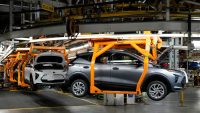Drastic drops in car dealers’ profits are going to get worse before they get better and retailers face a battle for ‘survival of the fittest’.
That is the verdict of Swansway boss Peter Smyth, who believes that dealers will need to ‘roll up their sleeves’ if they are to see out a difficult 2024.
It comes as several dealers begin to file their annual accounts, with the vast majority enduring their worst year since before Covid.
In fact, since mid-August, Car Dealer has reported on new fewer than seven sets of accounts – all of which show falls in pre-tax profit.
This has included the likes of Listers, Vindis, Vospers, Hartwell, Holdcroft, Vines and John Clark Motor Group, despite the vast majority of them enjoying improved turnover.
So, is this reduction in profit merely a correction in the market following a ‘Carlsberg’ period for dealers, or is there something more serious going on?
For Smyth, who has been a Swansway director for over 20 years, the latest trend is a sign that ‘the glory days of the pandemic are long behind us’.
He pointed to rising interest rates and shrinking margins as reasons for dealers to be fearful about what could happen to their profits over the coming years.
He told Car Dealer: ‘Factors affecting 2023 results reflect the rising interest rates in a lot of cases doubling the cost of borrowing for many, compared to borrowing costs in 2022.
‘The market is normalising and getting back towards 2019 levels of business. Unfortunately the “glory days” of the pandemic are long behind us.
‘There have been increased pressure caused by salary increases to staff as a result of the cost-of-living crisis, including increases for Technicians and parts people which has impacted the margin on aftersales.
‘New car stock is plentiful driving new car margins down, coupled with the fact the industry is wrestling with trying to sell an ever-increasing number of electric vehicles against a backdrop where customer demand doesn’t appear to be there.
‘The issue doesn’t only lie with new car stock, quality used cars is still hard to source so you find the same dealers trying to buy the same stock, therefore driving the wholesale price up consequently depressing the retail margins one is able to make on the used car.
‘In summary, there was a universal decrease in pre-tax profits in 2023 and I expect this to be worse in 2024. In short, everyone will have to roll up their sleeve and it will be survival of the fittest.’
‘Comparing 2023 and 2022 is like comparing apples and oranges’
To find out what exactly is to blame for the falling profits, we have been speaking to some industry experts.
Among them was Steve Young, managing director of automotive researcher, ICDP, who pointed to a ‘return to a full push environment’ and ‘huge instability in used car values’ as major contributing factors.
He added that challenges around the switch to EVs had caused several headaches for dealers up and down the country, as had the cost-of-living crisis.
However, he warned against making too many comparisons with the previous year’s results, due to the exceptional circumstances coming out of the pandemic.
‘Results for last year were still a bit flattering as some of the effects of supply restrictions in 2021 fed through into 2022, meaning there was more balanced supply and demand,’ he told Car Dealer. The used car market was also strong that year,’ he added.
‘When we then moved into 2023, we were back into a full push environment, had huge instability in used car values that some dealers rode better than others, and started to get into the BEV challenges which have now become locked in this year through the ZEV mandate.
‘We also got the full impact of the cost-of living-crisis last year so that interest rates were higher and there were inflationary pay awards.
‘Taken together, a 2023 to 2022 comparison is therefore a bit of an apples for oranges comparison – you would expect everyone to be reporting significantly worse bottom line %, though the more agile operators will perhaps have ridden the storm better.’
We also spoke to Ian McMahon, automotive partner at UHY Hacker Young, who said that rising costs across the board have had their impact on dealers’ results.
He told Car Dealer: ‘Following the strong used car profits in the months after covid, the 2023 results of many dealer groups have started to show a decline, as these come into the public domain.
‘Many dealer groups that we work with have been very responsive to the changes in guide values of their used (and demonstrator) vehicle stock. Unfortunately when we look back on 2023, this means that their used car inventories were, on the whole, subject to some significant provisions in Q4, such that they were able to trade effectively into 2024.
‘This against a backdrop of increased salaries, increased interest costs/rates (both on financing and stocking facilities) and a general increase in overheads has meant that the reported return on sales percentage is less than the prior year.
‘As we enter 2024, the new car retail market has faced some challenges, both with the inevitable “cost to change” for customers and the cost of retail finance.’
Despite the challenges which dealers continue to face, McMahon believes that there are reasons to be positive as the industry looks to the future.
He added: ‘There is plenty of positivity in the sector, especially as we see the anticipated agency model take less precedence on the retailers board meeting agendas.
‘We are seeing plenty of progress being made, where retailers assess what can be improved with a very focussed drive on enhancing overhead absorption.’
Profit situation is ‘nuanced’
Dealers are navigating ‘considerable complexity’ and a ‘nuanced’ approach is needed when analysing their financial results.
That is the verdict of Cox Automotive’s Philip Nothard, who also pointed to reduced margins and increased overheads.
He also told Car Dealer that ‘uncertainty and pressure’ are being felt across the ‘entire automotive ecosystem’.
Nothard, insights director at Cox Automotive, added: ‘While it is tempting to view this year’s lower pre-tax profits as a return to normal after an exceptional 2022, the reality is more nuanced. Comparing exceptional years in isolation can lead to a misleading understanding of performance.
‘Dealers are navigating considerable complexity, including significant transitions in local and global automotive sectors, compounded by ongoing economic uncertainties.
‘These factors make simple year-on-year comparisons insufficient for capturing the complete picture.
‘A key trend affecting profits is the rise in operational costs, which don’t directly contribute to revenue. At a time when both new and used vehicle margins are under pressure and consumer demand remains subdued, these increased costs are eating into dealer profitability.
‘These challenges are not confined to retailers alone — uncertainty and pressure are being felt across the entire automotive ecosystem, from OEMs to related industries.’



































